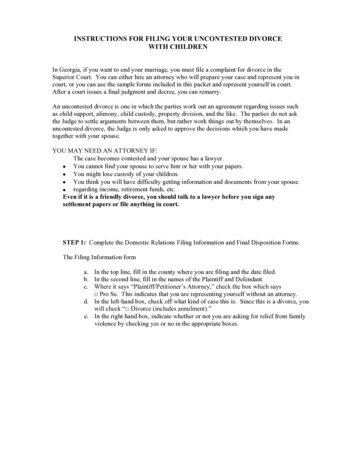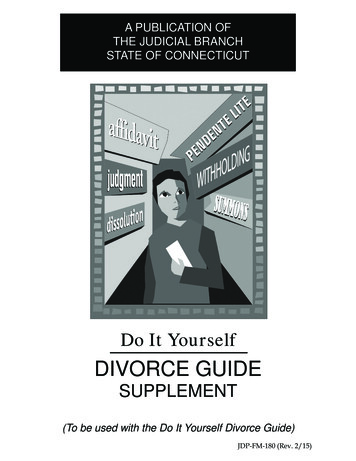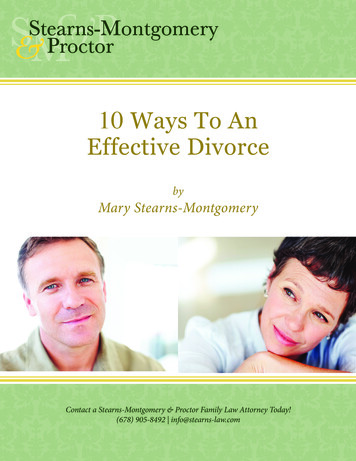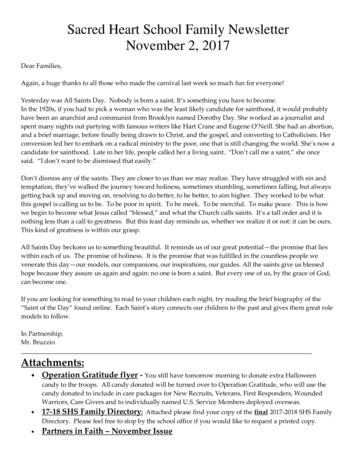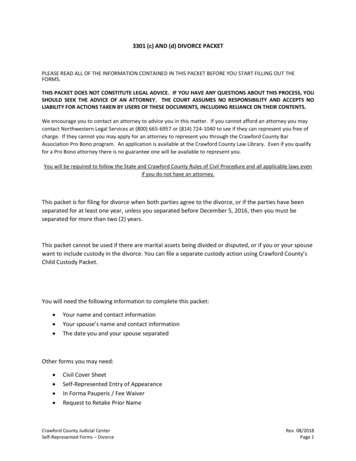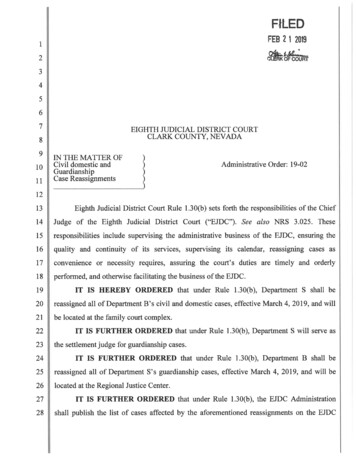
Transcription
A PUBLICATION OFTHE JUDICIAL BRANCHSTATE OF CONNECTICUTesrp oNGIDLOIW THHSUMMONSDo It YourselfDIVORCE GUIDE
“All courts shall be open, and every person, for an injury done to him in his person,property or reputation, shall have remedy by due course of law, and right and justiceadministered without sale, denial or delay.”Connecticut State ConstitutionArticle I, Section 10This “Do It Yourself Divorce Guide” is designed to help people without formallegal training use Connecticut’s state courts. It is available at any Superior Court Clerk’sOffice, the Public Information Desks, the Court Service Centers, and at the JudicialBranch website at www.jud.state.ct.us.The Connecticut Judicial Branch gratefully acknowledges contributions to thisGuide made by the Superior Court Judges, the legal services programs of Connecticut, theFamily Law Section of the Connecticut Bar Association, individual attorneys, and courtpersonnel.
DO IT YOURSELF DIVORCE1Do It YourselfDIVORCE GUIDEJudicial BranchState of Connecticut
DO IT YOURSELF DIVORCE2TABLE OF CONTENTSIntroduction . 4Family Violence . 5Overview . 6Common Words in a Divorce . 8Court Personnel . 11Starting a Divorce . 13Prepare Court Forms . 14Take the Forms to the Court Clerk’s Office . 17Service . 17File the Court Forms at the Court Clerk’s Office . 18Court Orders Before the Divorce Judgment (Pendente Lite). 18Responding to a Divorce . 19File an Appearance Form . 20File an Answer and/or Cross Complaint . 21Court Orders Before the Divorce Judgment (Pendente Lite). 21 Automatic Court Orders . 22Automatic Court Orders . 23The 90-Day Waiting Period . 25Prepare and Exchange Financial Affidavits . 27Attend Parenting Education Classes . 28Special Issues with Children . 28Contact Military if Your Spouse’s Location is Not Known . 28Case Management Process . 29Court Orders Before the Divorce Judgment (Pendente Lite). 30Prepare Motion . 31File the Motion . 31The Court Hearing . 31Custody . 32Visitation . 32
DO IT YOURSELF DIVORCE3Alimony . 33Child Support . 34Educational Support Orders . 34Health Insurance for Your Child . 34Parenting Education Program . 35Paternity . 35Finalizing Your Divorce . 36Prepare the Court Documents for the Uncontested Hearing . 37The Court Hearing . 39Judgment Form . 40Additional Information . 41Enforcing Your Court Order . 42Modifying Your Court Order . 43Mediation . 44Legal Advice or Representation . 44Family Violence . 45Advocacy/Support Groups . 46Statutes . 47Court Rules . 47List of Legal Holidays . 48Connecticut Judicial District Courts . 49Court Forms Discussed in this Guide . 52
DO IT YOURSELF DIVORCE4INTRODUCTIONThis booklet is designed to help you represent yourself in adivorce. Legal words and court documents can be confusing. Themore you know about how to get a divorce, the more comfortableyou will be when you complete the necessary court forms and appearin court. This booklet gives you the information you need to start adivorce or respond to divorce papers. The most commonly usedcourt forms you need to start a divorce are in the Divorce GuideSupplement ( JDP-FM-180) and should be used with this guide.Court staff can answer procedural questions and help you understand the legal process, but cannot provide you with any legal advice.The decision to get divorced can be difficult. You may beconcerned about money, your children, or finding a place to live.Please check the Additional Information section beginning on page41 for the names and telephone numbers of organizations whichmay be available to help you with the emotional and practical issuesof divorce.Note: If you need more information or assistance after reading this guide, youshould either consult an attorney or read the appropriate sections of the ConnecticutGeneral Statutes and the Connecticut Practice Book. Divorce in Connecticut isgoverned by General Statutes Section 46b-40 and the sections that follow, andPractice Book Chapter 25. The General Statutes and Practice Book are available inthe Superior Court Law Libraries located throughout the state as well as on theJudicial Branch website located at www.jud.state.ct.us.
DO IT YOURSELF DIVORCE5WARNINGFAMILY VIOLENCEIf you are being physically abused or threatened withphysical abuse by your spouse, you should contact thepolice and the family violence program nearest you. CallInfoline at 211 for information on a family violenceprogram near you. You should speak with an attorney or afamily violence program staff person if you are worriedthat your spouse will become more violent when he orshe learns that you are filing for divorce. Family violenceprogram services include: emergency shelter,counseling, 24 hour hot lines, information, supportgroups, advocacy, and referrals. You may also qualify fora court order called a restraining order to help protectyou from physical abuse or the threat of physical abuse.The first step is to fill out an “Application for Relief fromAbuse.” You may get this form from the Judicial Districtclerk’s office or from the Judicial Branch website atwww.jud.state.ct.us.STOPCall Infoline at211 for a familyviolence programnear you.
DO IT YOURSELF DIVORCE6OVERVIEWThe best way tofind a marriagecounselor isthrough word ofmouth. Get areferral fromsomeone youtrust, like afriend, a pastor,or a socialworker. Youmay also look inthe yellow pagesunder any ofthese erapists, or SocialWorkers.Getting divorced is an important decision. Before you decideto get a divorce, you may want to meet with a family counselor. Acounselor is someone who can help you identify issues concerningyour marriage and your decision to get a divorce.If you cannot work out your differences, divorce is a way tolegally end your marriage. If you decide to end your marriage, thisbooklet will help you represent yourself. A “Do It Yourself Divorce”is called a pro se dissolution. Pro se means “for yourself.” Dissolutionis the word Connecticut law uses for divorce.This booklet contains general information for uncomplicatedcases. It should only be used when you and your spouse agree on thebasic issues. If you and your spouse disagree about child custody orother important issues, you should seriously consider getting anattorney.Not everyone can afford an attorney and court staff cannotgive you legal advice. If you have a low income, you may be eligiblefor free legal services. To learn if you qualify for free legal services,you may call Statewide Legal Services at 1-800-453-3320. Theintake workers who answer the telephone speak English and Spanish.There are many stages of a divorce. When you and yourspouse agree on basic issues, it takes approximately four months tocomplete a divorce. One way to reach an agreement on basic issues isto work with a mediator. The clerk’s office has lists of mediators whocan help you for free or for a fee. (See Additional Information onpage 41.) The Judicial Branch’s Court Support Services Division(CSSD), Family Services Office of the courts, can also mediatedivorce cases. Its services are free.Regardless of who starts the divorce, the judge will listencarefully to you and to your spouse.
DO IT YOURSELF DIVORCE7You will find a list of all forms referenced in this guide on page 52 inthe Additional Information section. The most commonly used court formsyou need to start a divorce are provided in the supplement to this booklet.The Divorce Guide Supplement is available at any Judicial District clerk’soffice. See page 49 for a listing of Judicial District courts. Please reviewthe common words and the descriptions of court personnel that you willneed to work with beginning on page 8. Then, to start a divorce, turn topage 13. To respond to divorce papers, turn to page 19.TIPSThe amount of paper in a court case can be overwhelming.Start out right and follow these tips:1Always write down the date and the name of the courtpersonnel, state marshal or others who give you instructionsor explain things to you.2When you must mail something, you may wish to send it by“certified mail” with a “return receipt” so you have proof thatyou mailed it and that it was received.345Keep all documents, notes and receipts in a file, envelope orbinder.When you file a document with the court, include the fulldocket number and case name.Always keep a copy of every document for yourself. Do notgive away your only copy of a document.
DO IT YOURSELF DIVORCE8COMMON WORDS IN A DIVORCEDivorce involves complex laws and procedures. If you are getting divorced,here are some words that you should know.AlimonyMoney a court requires one spouse to pay the other spouse for supportbefore and/or after the divorce is granted. If you do not ask for alimonyat the final hearing, you can never get it in the future.AnnulmentA court order declaring that the marriage is invalid.ArrearagesMoney for court ordered alimony and/or child support which is overdueand unpaid.AutomaticCourt OrdersCourt orders that take effect when the divorce process begins.Broken DownIrretrievablyThe most common reason for granting a divorce. It means there is nohope of the husband and wife reconciling.Child Support Money paid by a parent to help meet the financial needs of a child.ComplaintA legal paper that starts your case and tells the court what you want.CustodyA court order deciding where a child will live and how decisions aboutthe child will be made. Parents may ask for any custody arrangementthat they believe is in the best interest of their child.DefendantThe person who is served with divorce papers.DissolutionThe legal end of a marriage, also called a divorce.
DO IT YOURSELF DIVORCE9Docket NumberA unique number the court clerk assigns to a case. It must beused on all future papers filed in the court case.FilingGiving the court clerk your legal papers.FinancialAffidavitA sworn statement of income, expenses, property (calledassets) and debts (called liabilities).IncomeWithholdingOrderA court order to deduct child support or alimony paymentsfrom someone’s income.Judgment FileA permanent court record of the court’s final decision.LegalSeparationA court order describing the conditions under which twomarried people will live separately.No-FaultDivorceThe most common kind of divorce, where no one needs toprove that the husband or wife caused the marriage to end.PartiesThe people who are named as plaintiff and defendant on legalpapers.PaternityLegal fatherhood.Pendente LiteOrderA court order made before a divorce is granted.PlaintiffThe person who starts the divorce.
DO IT YOURSELF DIVORCE10Pro SeFor yourself.Pro Se Divorce Do it yourself divorce.RestrainingOrderA court order to protect someone from physical abuse or the threat ofphysical abuse.Return DateThe date when the divorce action starts in court and when the 90 daywaiting period for a divorce begins. Also, the defendant should file anappearance on or before the second day after the Return Date.Nothing happens in court on the Return Date and no one needs to goto court on the Return Date. The Return Date is always a Tuesday.ServiceThe legal method for giving your spouse a copy of the court papersbeing filed, or notice that court action is being taken or has been taken.VisitationA court order deciding the amount of time a noncustodial parent mayspend with his or her child; also called parenting time, or access.
DO IT YOURSELF DIVORCE11COURT PERSONNELTo get a divorce, you will need to speak to many people who work in the courtsystem. You will know better what to expect from them after you review thedescriptions below.CaseflowCoordinatorKeeps track of your case and manages the scheduling of hearingsand trials.Court ClerkMaintains the official court record of your case. The clerk’s officereceives all court papers and may assign hearing dates.CourtInterpreterTranslates court hearings from English to another language. May beprovided at state expense for cases enforcing child support orders, ifrequested. You must provide your own interpreter in a divorce.CourtRecordingMonitorRecords the court hearing on audio tape. Prepares a written record ofthe hearing for a fee, if requested.CourtReporterTypes everything said during the court hearing. Prepares a writtenrecord of the hearing for a fee, if requested.FamilyRelationsCounselorMediates disagreements and negotiates agreements in divorce cases. Atthe request of the judge, a family relations counselor may evaluate afamily situation by interviewing each parent and the children in thefamily and writing a report for the judge, making recommendationsabout custody and visitation. Works in the Judicial Branch’s CSSDFamily Services Office.
DO IT YOURSELF DIVORCE12FamilySupportMagistrateDecides cases involving child support and paternity. Can also enforce courtorders involving paternity, child support and alimony.JudgeHears and decides cases for the courts.JudicialMarshalResponsible for courthouse security including the metal detectors at theentrance of each courthouse and maintains order in each courtroom.Law LibrarianMaintains legal reference and research materials for public use.State Marshal A state marshal can serve (give copies of ) the legal papers on the otherpeople named in the lawsuit.SupportSupervises child support payments and brings parents to court to enforceEnforcement child support orders. May also file legal papers to modify or change childsupport orders.Officer
DO IT YOURSELF DIVORCE13STEP 1STARTING A DIVORCEPrepare Court FormsTake the Forms to the Court Clerk’sOfficeServiceFile the Court Forms at the Court Clerk’sOfficeCourt Orders Before the DivorceJudgment (Pendente Lite)
DO IT YOURSELF DIVORCE14STEP 1STARTING A DIVORCEEvery officialcourt form has aname and anumber like JDFM-100 in theupper left handcorner of the form.You may pick aJudicial Districtwhich serves eitheryour town ofresidence or thetown where yourspouse lives.To start a divorce, you will need three court forms: the SummonsFamily Actions ( JD-FM-3), the Divorce Complaint/Cross Complaint( JD-FM-159), and the Notice of Automatic Court Orders ( JD-FM-158).Once you complete your paperwork, you must take it to the court clerk’soffice. The court clerk will review your completed forms and returnthem to you. Your spouse must be given a copy of the divorce papers bya state marshal, which is referred to as “serving the papers.” Finally, tostart a divorce you need to file at the court clerk’s office the completedcourt forms and the proof that a copy of the forms was served on yourspouse. You must also pay the filing fee, unless it is waived. All of thecourt forms underlined below are listed in the back of this booklet.Court forms are available at the clerk’s office in any Judicial Districtcourthouse, the Court Service Centers and Public Information Desks atselected courthouses. They are also available on the Judicial Branchwebsite at www.jud.state.ct.us.Prepare Court FormsComplete a Summons Family Actions ( JD-FM-3). ASummons directs an officer (usually a state marshal) tonotify your spouse that you are starting a divorce. ASummons tells your spouse to file an Appearance ( JDCL-12), so he or she can respond to the lawsuit and receive noticesfrom the court about all future court dates. Do not sign the Summonsuntil you appear before the court clerk. Be prepared to show the clerkphoto identification. Select the correct Judicial District courthouse and fill it in on theSummons. (See list of Judicial Districts on page 49.)
DO IT YOURSELF DIVORCE15Select a Return Date. It must be a Tuesday and should be at least fourweeks after the day you bring the papers to the court clerk. Fill in theReturn Date on the Summons, the Complaint and any other papers.Neither party is required to physically appear at court on the Return Date. Prepare a Divorce Complaint/Cross Complaint ( JD-FM-159). AComplaint is an important legal document because it is the way to tell thecourt and your spouse what you want. In the Complaint you can ask ajudge to end your marriage, grant alimony, award child custody, visitation,child support, divide your marital property and debts, or restore a priorname. Be sure and check the box at the top of the form showing that it isa Complaint and not a Cross Complaint (which can be used by thedefendant). Attach a completed copy of the Notice of Automatic Court Orders ( JDFM-158). These court orders take effect at the beginning of a divorceand apply to you when you sign the complaint. They apply to your spousewhen your spouse is served with a copy. These court orders protect you,your spouse and your children from changes in your life, such as onespouse selling the family home or taking the children out of state. (SeeAutomatic Court Orders on page 22 for more information.) You must fillin the case management date at No. 4 on the Notice of Automatic CourtOrders. The case management date is set by the court and is at leastninety days after your Return Date. Select the appropriate date from theCase Management Dates form ( JD-FM-165 A, B, or C depending onyour court location) or ask the court clerk for the correct casemanagement date. If you need other court orders, complete the Motion for Orders BeforeJudgment ( JD-FM-176), and have it served with the Summons,Complaint, and Notice of Automatic Court Orders. (See page 22 formore information.) The AutomaticCourt Ordersprotect you, yourspouse and yourchildren fromchanges in yourlife, such as onespouse selling thefamily home ortaking thechildren out ofstate.
DO IT YOURSELF DIVORCE16If you cannot afford the court fees for a divorce, complete anApplication for Waiver of Fees/Appointment of Counsel ( JD-FM-75). Theform asks for information about your income and expenses. This is yourchance to show the court why you cannot afford to pay the filing fee, thestate marshal’s charge, and other costs such as the fee for the parentingeducation class. Do not sign the form until you are in front of a courtclerk, a notary public or someone else who is qualified to hear yourpromise or oath that what you report about your financial situation istrue. A judge will review your application and decide whether or not togrant it. If the judge denies your application to have the filing fee and thestate marshal’s fee paid by the state, you may request a hearing.Complete the appropriate section on the Application for Waiver of Fees.If you need a fee waiver, you should complete this process before thepapers are served. How much does adivorce cost? 225Court filing feeState Marshal’sfee for serving 50papers(approximate cost) 125ParentingEducation Class(if you have children)Total 400(for most cases)Newspaperpublication oflegal notice(if you can’t findyour spouse) 350(approximate cost)Total 750If your spouse lives outside the state and you know his or her address,complete a Motion for Order of Notice in Family Cases ( JD-FM-167) andgive it to the clerk, accompanied by the Order of Notice in Family Cases( JD-FM-168). The clerk will review the forms and sign the Order ofNotice in Family Cases. You can start the case by having a state marshalsend copies of the following documents to your spouse by certified mail: theSummons; Complaint; Notice of Automatic Orders; Motion for Order ofNotice in Family Cases; and the Order of Notice in Family Cases; or byhaving the state marshal provide notice in whatever other manner isordered. If you do not know your spouse’s address, try to find it through friendsand relatives. If you cannot find the address, you must get permission fromthe court to publish a notice about starting the divorce in a newspaper in thearea where your spouse lives or was last known to live. If you do not knowthe name of a newspaper, a librarian at a public library should be able tohelp you. Call the newspaper to find out the cost of printing a legal notice.If you cannot afford to pay this amount, include it on your Application forWaiver of Fees. Complete a Motion for Order of Notice in Family Cases( JD-FM-167) and give it to the clerk, accompanied by the Order of Noticein Family Cases and get the order signed by the court clerk. The court mayorder notice to be given to your spouse as it deems reasonable. If so, youmust notify your spouse in the manner the court has ordered.
DO IT YOURSELF DIVORCE17Take the Forms to the Court Clerk’s Office Court clerk signs Summons.Court clerk can witness your sworn signature on your Application for Waiver of Fees. The clerk will tell you whether thejudge will rule on your application that day, or whether youshould leave all of your court forms for the judge to review. The court clerk will return the original Summons, Complaint, andNotice of Automatic Court Orders to you to be served. Get a list of state marshals for the Judicial District where your spouselives and works from the clerk’s office. ServiceContact a state marshal in the judicial district where your spouse lives orworks. You may get a list of state marshals from the court clerk. Most state marshals will charge approximately 50 toserve a Summons, Complaint and Notice of AutomaticCourt Orders. The state marshal may require payment inadvance or may be willing to bill you. Speak to the state marshal to be sure he or she is available to serve yourspouse at least 12 days before the Return Date. Ask the state marshalabout payment and arrange to give the state marshal the court papers. The state marshal will either return the original papers to you once heor she serves a copy on your spouse or will file them with the court. Findout ahead of time if the state marshal will be filing the original paperswith the court and, if so, how the filing fee will be paid to the clerk. The state marshal will prepare a document called a “Return of Service”which is proof that the papers were served. This document along withthe original papers you brought to the state marshal must be filed with thecourt clerk at least six days before the Return Date.
DO IT YOURSELF DIVORCE18If you or your spouse ever received public assistance from the Stateof Connecticut, send a copy of the court forms and state marshal’sreturn of service to: Attorney General’s Office, 55 Elm Street, Hartford, CT 06106. Complete a Certification (Public Assistance) ( JD-FM175 ) that tells the court that you mailed the papers to the AttorneyGeneral. If you or your spouse ever received public assistance from a town inConnecticut, send a copy of the court forms and state marshal’s returnof service to the town clerk located in the town hall of that town. Theblue pages of the telephone book will have the address. Complete aCertification (Public Assistance) that tells the court that you mailed thepapers to the town clerk. File the Court Forms at the Court Clerk’s OfficeThe original Summons, Complaint, Notice of AutomaticCourt Orders, state marshal’s return of service and the filingfee (or the original Application for Waiver of Fees if it wasgranted by the judge) must be brought or mailed to the courtclerk’s office. The court clerk must receive it at least six daysbefore the Return Date. Also, if public assistance was received, bring thecompleted certification. You will have to pay the filing fee unless it hasbeen waived. The current filing fee is 225. You may pay by cash, moneyorder, or a personal check made payable to “Clerk, Superior Court.” If youare paying by personal check, bring photo identification and make sureyour address is pre-printed on the check. The address on your checkshould match the address on your photo identification. Please note thatthe courts may accept certain credit cards. It is recommended that youverify this in advance. Pendente Litemeans duringthe case, i.e.,before the judgment of divorce.Court Orders Before the Divorce Judgment (Pendente Lite)You may ask the court at any time to enter court orders concerningalimony, child support, custody, visitation, and exclusive possession ofproperty. You do not have to wait until the final divorce hearing. Youwould have to file a written request (called a motion) with the court clerk.(See pages 21 and 30 for more information.) The earliest that you may filea motion is with the original Summons, Complaint and Notice of Automatic Court Orders.
DO IT YOURSELF DIVORCE19STEP 2RESPONDING TO A DIVORCEFile an Appearance FormFile an Answer and/or Cross ComplaintCourt Orders Before the Divorce Judgment(Pendente Lite)
DO IT YOURSELF DIVORCE20STEP 2RESPONDING TO A DIVORCEThe AutomaticCourt Ordersapply to you whenyou receive theSummons andComplaint, even ifthey are nothanded to youpersonally by thestate marshal.You are a defendant in a divorce case if you have been served with acopy of the court forms called a Summons, Complaint, and Notice ofAutomatic Court Orders. A state marshal may hand them to you or leavethem at your home. It is important that you read all documents. Read thenotice in the middle of the Summons carefully. Read the Notice of Automatic Court Orders attached to the Complaint very carefully. They applyto you when the Summons and Complaint are served on you. The Automatic Court Orders also give you a case management date. You and yourspouse must complete a Case Management Agreement and file it with theclerk before that date. If you disagree about custody or visitation of yourchildren, you and your spouse must go to court on the Case ManagementDate.After you get a copy of the court papers, you may contact an attorney to represent you or follow the steps below to represent yourself. Evenif you agree with what your spouse says in the complaint, follow the stepsbelow to participate in your case. If you take no action, the judge mayorder what your spouse requests in the Complaint.File an Appearance FormFile an Appearance ( JD-CL-12) to tell the court that youare acting as your own attorney. Although you may file anAppearance anytime before the final hearing, it is best tofile it in person or by mail with the court clerk no morethan two days after the Return Date. The Return Date isin the upper right corner of the Summons form. TheReturn Date is not a trial date. No one has to go to court onthe Return Date. There are legal consequences to filing an Appearance. Once you file anAppearance you will receive all court calendars and papers filed regardingyour case. After you file your Appearance, the court will send you noticeof the docket number assigned to your case. Once you receive this number, use it on all papers you file with the court, and provide it to courtpersonnel when you make an inquiry about your case.
DO IT YOURSELF DIVORCE21File an Answer and/or Cross ComplaintYou do not have to file an Answer ( JD-FM-160) to thecomplaint, but it is a good idea to do so. Your Answer willtell the court whether you agree or disagree with eachnumbered statement in the Complaint. Youdo not have to file a Divorce Complaint/Cross Complaint ( JD-FM159), but filing a Cross Complaint lets the court know what you want.It also allows the divorce to continue even if your spouse decides to stopor withdraw the case. If you do file a Cross Complaint, make sur
The Divorce Guide Supplement is available at any Judicial District clerk’s office. See page 49 for a listing of Judicial District courts. Please review the common words and the descriptions of court personnel that you will need to work with beginning on p
